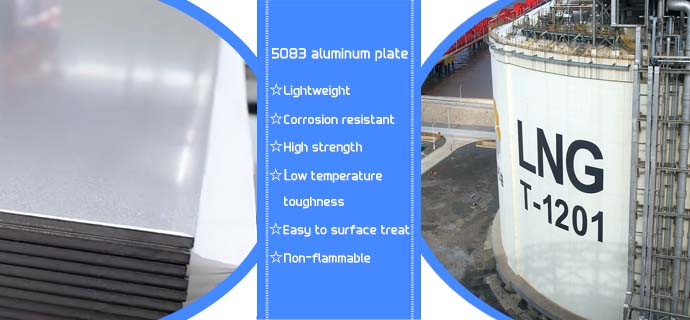- Email: sales@flait-aluminum.com
- Tel: 0086-13203837398
◆ Lightweight and corrosion resistant
◆ High strength and good low temperature toughness
◆ Easy to surface treat and non-flammable
Liquefied natural gas (LNG) is an important clean energy source. To store liquefied natural gas, the tank must be able to withstand extreme temperatures and pressures. The liquefaction temperature of natural gas is -162℃, and the volume of liquefied natural gas is 1/600 of that in gaseous state, which makes the material requirements for LNG tanks higher.

5083 aluminum plate is a non-heat-treatable alloy containing magnesium, a small amount of manganese and chromium. 5083 aluminum plate has strong resistance to corrosion from seawater and industrial chemicals, and can still maintain excellent strength after welding. It is the most ideal material for building LNG tank shells. 5083 O aluminum plate is widely used in LNG tank aluminum alloy ceilings. 5083 aluminum plate belongs to aluminum-magnesium alloy, has good corrosion resistance and processability, high strength, excellent formability, and easy surface treatment. 5083 aluminum alloy has no low-temperature brittleness, and its mechanical properties do not decrease with the decrease of temperature. It can still maintain high strength at low temperatures. At the same time, the economy of aluminum alloy is relatively good, so it is widely used in LNG ships and LNG storage tanks.
 Corrosion resistance
Corrosion resistanceThe typical application of 5083 aluminum sheet plate is in LNG Tank environment. 5083 aluminum plate has good corrosion resistance in seawater and chemical environment, high stress corrosion cracking resistance and good low temperature performance make it useful for manufacturing transportation vehicle parts. 5083 alloy has high strength and can still maintain extremely high strength after welding. It is the strongest alloy among non-heat-treatable alloys, but it is not recommended to be used in environments with temperatures exceeding 65°C.
 Heat treatment
Heat treatment5083 aluminum sheet plate cannot be hardened by heat treatment. It can be hardened by cold working (cold rolling), soft annealed temper O and various “H” tempers: 5083-H116 aluminum plate, 5083-H111 aluminum plate, 5083-H112 aluminum plate and 5083-H321 aluminum plate, these aluminum plates are the most common aluminum alloy materials for marine construction and shipbuilding.
 Weldability
Weldability5083 aluminum plate has excellent welding ability for all standard electric welding, GMAW and GTAW are preferred and widely used to produce structural welds.
| Alloy | Temper | Thickness(mm) | Width(mm) | Application |
| 5083 | O,H111,H112,H116,H321 | 3-10 | ≤2600 | shipbuilding |
| 5083 | O,H111,H112,H116,H321 | 10-50 | ≤3600 | Marine, ship |
| 5083 | O,H111 | 3–10 | ≤2600 | Tank truck |
| 5083 | O,H12,H14,H16,H18,H19,H22,H24,H26,H28, H32,H34,H36,H38,H111,H112,H114,H116,H321 |
0.5-500 | 20-2650 | LNG storage tanks, gas storage cylinders, GIS shells, car body skins, flange materials, etc. |
| Element | Content (%) |
| Aluminum, Al | Remainder |
| Magnesium, Mg | 4.0 – 4.9 |
| Mangnese, Mn | ≤ 1.0 |
| Silicon, Si | ≤ 0.40 |
| Iron, Fe | ≤ 0.40 |
| Chromium, Cr | ≤ 0.25 |
| Zinc, Z | ≤ 0.25 |
| Titanium, Ti | ≤ 0.15 |
| Alloy | Temper | Tensile strength Rm(Mpa) | Yield strength Rp0.2 (Mpa) | Elongation A (%) | Exfoliation corrosion mg/cm2 | Intergranular corrosion | Standards |
| 5083 | O,H111,H112 | ≥275 | ≥125 | ≥16 | – | – | EN485 ASTM B928 |
| H116 | ≥305 | ≥215 | ≥10 | ≤PB | ≤15 | ||
| H321 | 305-385 | 215-295 | ≥12 | ≤PB | – |
| Physical properties | Value |
| Density | 2.65Kg / m3 |
| Melting point | 570℃ |
| Thermal expansion | 25×10-6/K |
| Elastic modulus | 72GPa |
| Thermal conductivity | 121W/M·K |
| Resistivity | 0.058 x10-6Ω·M |
Original Source:https://www.flait-aluminum.com/Aluminum-Sheet-for-Tank-Truck-Fuel-Tanker.html
Tags:5083 aluminum plate